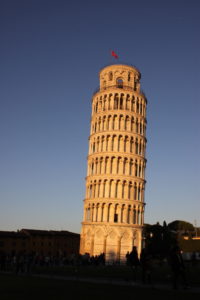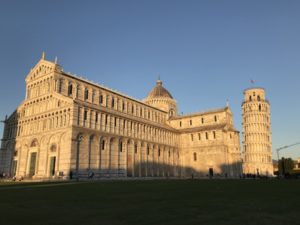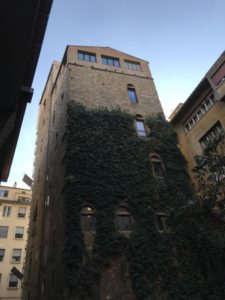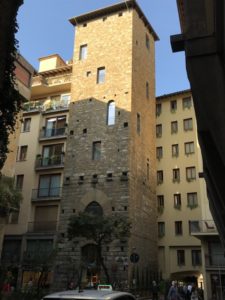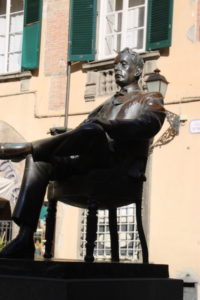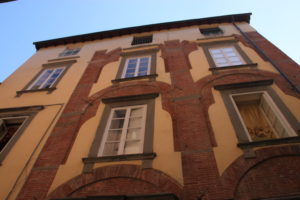San Gimignano, in Italy’s Tuscany, is well known for its medieval tower houses, structures built for defense — and built to show off wealth and power. However, plenty of other towns and cities, in Italy and beyond, once had or still have tower houses, or something similar, built at least partly for defense.
In Italy alone, I have seen examples of tower houses in Pisa, Florence and Lucca. Also, UNESCO, in discussing the reasons Siena’s historic city center is a protected site, refers to tower houses within the town walls, but I have not seen them, at least not wittingly.
As for the houses I have seen:
Pisa. During a 2007 visit, a tour guide said medieval Pisa was a “huge, rich city” where people built tall houses, the taller the more powerful the owner. He said there were 700 such houses (that number sounds suspiciously high to me!), but when Florence took over Pisa in the Middle Ages, it cut off the tops “to show who was boss,” he said.
Only three towers survive, he said. I have no photos (bad lighting), but the Leaning Tower remains the tower to see in Pisa anyway!
Florence. During my October 2018 visit, I toured the Dante House Museum. Its exhibits focus on the man and his “Divine Comedy” — and the story of the city where he lived.
From museum signage, I learned that by around 1300, Florence counted roughly 150 tower houses within the city walls, the tallest rising to about 245 feet. They were built for defense, given the bloody fights between feuding families within the city, and to maximize urban space. Tower houses generally had one room per floor, connected by wooden ladders, which could be pulled up in case of an enemy’s intrusion at ground level.
Then, a 1250 law mandated that houses be shortened, to stand no more than about 95 feet. By the 14th century, the need for defensive houses had faded, but a few remain.
With some help from Google, I found two near the Arno River, not far from the Ponte Vecchio on the same side of the river as the PItti Palace. These houses are not elegant to look at, at least not on the exterior, but who cares?
Lucca. My favorite tower houses, or tower house remains, are here. During the 2018 Italy trip, three friends and I joined a walking tour of Lucca, during which our guide Alexandra pointed out these medieval dwellings, most of them from the 14th century.
She said a lived-in tower would be both workplace and home for a single family, and the family would build higher as it became more prosperous. Added height yielded more living space despite the small plots, and there was a security element here, too, she said.
Also, the wealthy sometimes built towers next to living spaces just to show off. Like Florence, Lucca imposed legal limits on tower heights.

Looking for all the world like a tower meant for showing off, Lucca’s Guinigi Tower House has trees growing out of the top. Visitors can climb to the top of this one.
Lucca’s repurposed tower houses are relatively easy to spot because of a tradition for brick arches framing the old homes’ windows and street-level entries. Alexandra pointed out a set of three that had been combined to make a single large home. In another case, seven in a line had been combined for a single building.
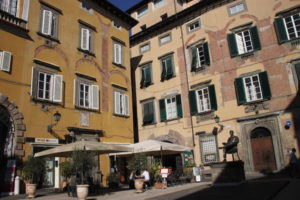
Above, former Lucca tower houses, identified by the brick arches visible on their exteriors. These houses sit on Piazza Puccini, named for the composer Giacomo Puccini, who was born in a house on this square. Below, a statue of the composer in the square.
These houses were so photogenic, which is a major reason I wrote this blog!

In Lucca, remains of tower houses are frequently visible, as on the house second from left on the street above. Below, more brick arches, revealing remnants of two Lucca tower houses.
Meanwhile, for more about Tuscany, we offer at BestTripChoices.com the following, under the headline, Medieval walls, Chianti wine: https://besttripchoices.com/international-touring-areas/tuscanyhill-towns-italy/
This blog and its photos are by Nadine Godwin, BestTripChoices.com editorial director and contributor to the trade newspaper, Travel Weekly. She also is the author of “Travia: The Ultimate Book of Travel Trivia.”

